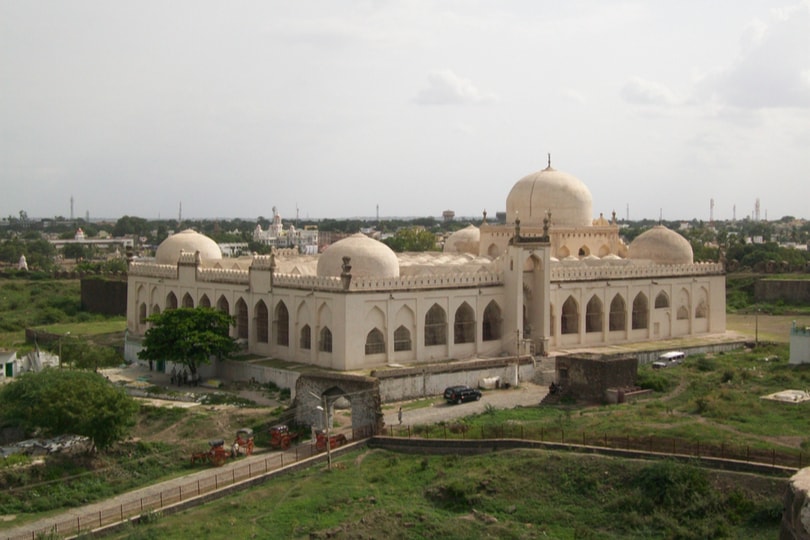

Gulbarga, officially known as Kalaburgi, is a city in the vibrant state of Karnataka. This beautiful city features an impressive legacy of Islamic art and is a great example of the diversity of India. There are very few cities that boast of such an eclectic mix of art, culture, and heritage, and Gulbarga is one of them. Gulbarga is 623 km north of the state capital city of Bangalore and 220 km from Hyderabad. Gulbarga is embellished with many enchanting sights with Gulbarga Fort and Gulbarga Dargah being two of the most famous of them.
The history of Gulbarga dates to the 6th century. It has mostly been under the rule of the Chalukyas. The region came under the control of Rashtrakutas, but the Chalukyas regained it after a short period and went on to rule for 200 years. The Kalyani Kalachuris who succeeded them ruled until the 12th century. Around the end of the 12th century, the Yadavas of Devagiri and the Hoysalas of Dwarasamudra destroyed the supremacy of the Chalukyas and Kalachuris of Kalyani.
Gulbarga has seen the rise and fall of many dynasties, and each of them has left their distinctive mark on the city. This is Gulbarga for you- a melting pot of different traditions, cultures, and lifestyles.


India is known for the great Sufi shrines dotted along the length and breadth of the country. One of the most revered of these shrines is the Dargah of the 14th-century Sufi mystic- Khwaja Bande Nawaz Gesu Daraz. Tucked away in the bylanes of Gulbarga, this shrine is dedicated to Khwaja Bande Nawaz who is credited with introducing Sufism to the south.
Let’s take you back in time. It was the 17th of December, 1398. The Central Asian conqueror Timur had just destroyed the Tughlaq armies outside Delhi and was camping at Hauz Khas, eagerly eyeing Delhi and the power this city carried since time immemorial. Sensing impending doom, a large entourage of people drove away from the city, heading as far south as possible. The very next day Timur’s army wreaked havoc in Delhi.
One among the thousands who were driven away was a 77-year-old man who was not an alien to the streets of Deccan. He had made the same journey in 1328 CE. Banda Nawaz was born to Syed walShareef Muhammad bin Yousuf AlHussaini in Delhi in 1321. When he was just 7 years old, his family was forced to migrate to Daulatabad because Muhammad Bin Tughlaq, the then Sultan of Delhi, changed his capital from Delhi to Daulatabad. 70 years later, this man saw himself undertaking the same journey, but not as a little boy but as Khwaja Bande Nawaz Gesu Daraz- a Sufi cleric. Little did he or those around him knew that he was going to make history.
Gesu Daraz belonged to the Chishti order of Sufism. The Chishti order of Sufism is a Sufi order which arose from Chisht- a small town near Herat in Western Afghanistan. The Chishti order of Sufism follows the tenets of Sunni Islam and believes in love, peace, and brotherhood. Sufism is one of the mystical orders that grew out of Islam. Classical Sufi scholars define it as a movement that leads to healing of the heart and making it one with nothing else but God. The Chishti order was introduced in South Asia by Sufi Sheikh, Moinuddin Chishti, whose famous Dargah is situated in Ajmer. Khwaja Nizamuddin Auliya was one of the most prominent Sufi clerics in the late 13th century India, and his Dargah now stands in Delhi.
Muhammad Hussaini more fondly known as Gesu Daraz was the disciple of the famous Khwaja Nasiruddin Chirag-Dehlavi, who had succeeded Khwaja Nizamuddin Auliya to get the distinction of premier Sufi Sheikh of Delhi.
After fleeing Delhi in 1398, following Timur’s invasion, Gesu Daraz and his followers made their way to Gwalior, Chanderi, Cambay, and then to Daulatabad, where he wanted to pay respects at his late father’s grave. Daulatabad was under the rule of the Bahmani Sultans. When Sultan Firuz Shah Bahmani heard that Gesu Daraz had stepped foot in his kingdom, he went to meet him there and invited him to the Bahmani, the capital of Gulbarga.
Gesu Daraz settled down in Gulbarga where he stayed for the next twenty-three years. Noted historian Richard Eaton, from the University of Arizona who has extensively chronicled the life of Gesu Daraz in his book ‘The Social History of Deccan’ writes how getting Gesu Daraz to Gulbarga was a political act on the part of the Sultan as he wanted religious sanction for his newly founded kingdom. In just a matter of few months, Gulbarga Gesu Daraz, who was already a well-respected commentator on Sufi philosophy, became a cultural phenomenon. One of his greatest contributions was the introduction of the Dakhani language in the Deccan, which later came to be known as Dakhni Urdu.
In 1422, Gesu Daraz passed away at the ripe age of 101. The Dargah of Gesu Daraz in Gulbarga, more popularly known as Gulbarga Dargah was constructed in the same year and was later expanded and enlarged in the year 1640. By the mid-17th century, this Dargah became one of the most prominent Sufi shrines in the entire country. Since then it has been attracting devotees and believers from all over the country to Gulbarga.
The Dargah is an architectural marvel and a perfect example of the amalgamation of Persian and Deccan architecture. It is venerated by both Muslims and Hindus. The walls and domes of this Dargah are adorned with paintings in Turkish and Persian styles. Some of the old relics of the saint are still preserved in the tomb. In the premises of the Dargah, there is also a library, containing about 10,000 books in Urdu, Persian, and Arabic, on history, philosophy, religion, etc. A mosque, Sarai, and a college built by Emperor Aurangzeb in 1687 AD lie near this tomb.
On the 15th, 16th, and 17th day of Zul-Qa’dah of Muslim calendar, the Dargah of Bande Nawaz ar Gulbarga witnesses people from different walks of life gathering here to celebrate the urs (death anniversary) of their beloved saint. Several hundred thousand devotees from near and far, irrespective of religion and beliefs, gather to seek blessings.
Built-in 1374, the Gulbarga Fort is one of the finest examples of the ancient Islamic style of architecture. The fort was originally built by Raja Gulchand. As Gulbarga gained prominence as the Bahmani capital, the fort was fortified by Alauddin Bahmani with a deep moat and massive walls. The fort is a well-planned structure, and one of its distinctive features is that it houses the world’s longest cannon inside it. The Bara Gazi Toph (Canon) which measures about 29 feet in length, is the longest canon in the world. The fort is surrounded by a canal, two prominent rivers namely Krishna and Bhima flow in proximity to this structure. The Dargah or tomb of Bande Nawaz, the great Sufi saint about whom we talked at length in the previous paragraphs, is situated inside the premises of this fort. Besides the famous Dargah, other important monuments here include the Jami Masjid, and the Khandar Khan’s mosque and Hirapur mosque built by Chand Bibi.
The Jami Masjid is one of the first-ever mosques in Southern India and was built to commemorate Gulbarga as the capital of the Bahmani dynasty. It is one of the most important places of religious significance in the southern part of India.
The Gulbarga Fort encompasses some of the finest aspects of Persian architecture. The fort’s design has been heavily inspired by the Great Mosque of Cordoba in Spain. It features arched doorways and has a tinge of Moorish architectural beauty. The gardens, mosques, arches, and palaces inside the fort gives us a great insight into the evolution of Indo-Persian architecture in South India. The structure is quite awe-inspiring and shows us the intelligence and finesse of the artists and architects of those days.
The fort is open from 9 am to 5 pm every day all year-round. However, summers in this region can be harsh. If you want to explore the fort and enjoy sightseeing to the fullest, it is advisable to visit it during the winter season. Anytime between January-March and October-December is an excellent time to visit the fort. During these months, the weather remains cool and you can enjoy your trip to the fullest. You can even take the stairs to the topmost point of the fort and witness spectacular views of the city around.
Sholapur is the nearest airport from the Gulbarga city. It is situated at a distance of 81 km from the city. Also, major cities like Hyderabad, Bangalore, and Chennai are well-connected to Gulbarga through trains as well as regular flights. From Bangalore and Mysore, you can reach Gulbarga on buses that operate regularly. Hyderabad is around 200 km away from Gulbarga.
If you want to experience the rich and diverse culture, history, and architecture of India, then Gulbarga is the perfect getaway for you. It is a laid-back town with a rich past and a hopeful future!
Noida, with its vibrant culinary scene, offers a plethora of options for dessert lovers craving…
Embarking on a journey? Make your travels more convenient and enjoyable with the latest accessories…
As the temperature drops and the chilly winds start to blow, staying warm and healthy…
Travel photography is not just about capturing moments; it's about immortalising experiences, landscapes, and the…
Embarking on a solo adventure can be exhilarating, offering the freedom to explore new destinations…
Business travel often entails tight schedules and hectic itineraries, leaving little room for packing mishaps…